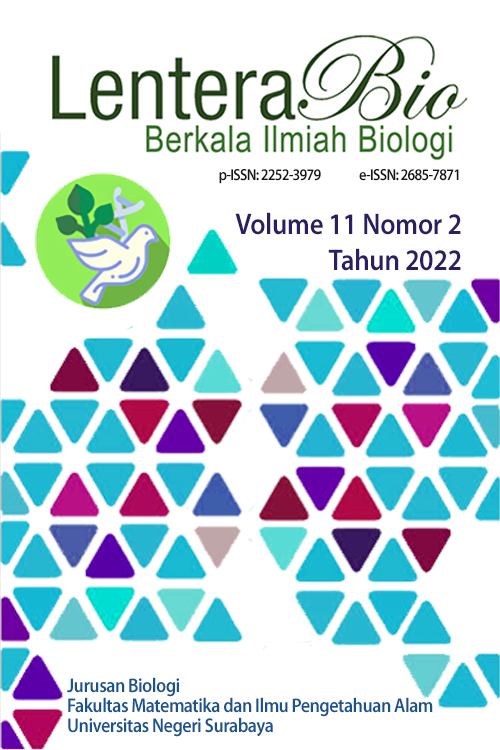The Effect of Fermentation of Acetobacter xylinum and Saccharomyces cerevisiae in Nutritional and Organoleptic Quality of Beetroot Flour (Beta vulgaris L.)
DOI:
https://doi.org/10.26740/lenterabio.v11n2.p351-358Keywords:
sensory evaluation, ash content, water content, glucose content, protein contentAbstract
This study aims to describe the effect of starter Acetobacter xylinum and Saccharomyces cerevisiae on the nutritional and organoleptic qualities of beetroot flour (Beta vulgaris L.). This research is an experimental research. The experiment was arranged in a Completely Randomized Design (CRD) with 6 replications. This research has 3 treatmments, namely the addition of starter A. xylinum (A), S. cerevisiae (S), and without fermentation as controll (K). This research process is includes the preparation for starter A. xylinum with a number 108 cell/ml and S. cerevisiae with a number 108 cell/ml, liquid fermentation of beetroot, flouring process, nutitional analysis (water content, ash content, protein content, and glucose content), and organoleptic analysis (taste, aroma, color, and texture). The result showed that the addition of starter in the beetroot fermentation had a significant effect on nutitional and organoleptic qualities of beetroot flour. The water content of K treatment was 15%, ash content was 5,2%, protein content was 5,85%, and glucose content was 10,31%. The water content of S treatment 9,67%, ash content was 11,28%, protein content was 1,04%, and glucose content was 2,05%. The water content of A treatment was 13,33%, ash content was 5,41%, protein content was 10,31%, and glucose content was 8,67%. Based on the results of the organoleptic test , the K treatment was not favored by the panelists in color, aroma, texture, and taste aspect. The S treatment, the aroma and texture aspect were very favored by the panelists. The A treatment, the color and taste aspect were very favored by the panelists. The A treatment produced the best characteristics of beetroot flour, both in terms of nutrisional content and organoleptic aspect.
References
Anggraeni, R. S. S. (2018). Pengaruh Penambahan Tepung Umbi Bit (Beta Vulgaris L) sebagai Substitusi Tepung Tapioka pada Sosis Ikan Patin (Pangasius Sp) terhadap Penerimaan Konsumen.
Badan Standardisasi Nasional, B. (2009). SNI 3751:2009. Tepung Terigu Sebagai Bahan Makanan.
Juliana, R. (2017). Pengaruh Metode dan Lama Fermentasi terhadap Karakteristik Fisikokimia dan Fungsional Tepung Ubi Jalar Ungu.
Mandel. (2004). Capability of Acetobacter xylinum to Convert Celluose. McGraw Hill.
Radiena, & Mozes, Y. (2016). Umur Optimum Panen Pisang Kepok (Musa paradisiaca, L) Terhadap Mutu Tepung Pisang.MajalahBiam,12(2).http://portalgaruda.fti.unissula.ac.id/index.php?ref=browse&mod=viewarticle&article=481364
Soekarto. (1985). Penilaian Organoleptik Untuk Industri Pangan dan Pertanian. Bharata Karya Aksara.
Trinanda, M. (2015). Studi Aktivitas Bakteri Asam Laktat (L. plantarum dan L. fermentum) Terhadap Kadar Protein Melalui Penambahan Tepung Kedelai Pada Bubur Instan Terfermentasi.
Winarno. (1997). Kimia Pangan dan Gizi. Gramedia Pustaka Utama.
Downloads
Published
How to Cite
Issue
Section
License
Copyright (c) 2022 LenteraBio : Berkala Ilmiah Biologi

This work is licensed under a Creative Commons Attribution-NonCommercial 4.0 International License.
Hak Cipta (c) LenteraBio: Berkala Ilmiah Biologi
Karya ini dilisensikan di bawah Lisensi Internasional Creative Commons Attribution-NonCommercial 4.0.
Pemberitahuan Hak Cipta.
Hak cipta dari artikel yang diterima untuk diterbitkan akan diberikan kepada jurnal sebagai penerbit jurnal. Hak cipta yang dimaksud meliputi hak untuk menerbitkan artikel dalam berbagai bentuk (termasuk cetak ulang). Jurnal mempertahankan hak penerbitan atas artikel yang diterbitkan.
 Abstract views: 1114
,
Abstract views: 1114
, PDF Downloads: 1862
PDF Downloads: 1862











